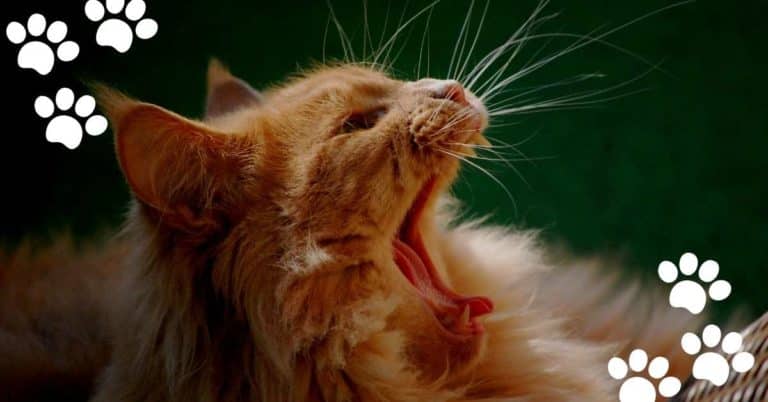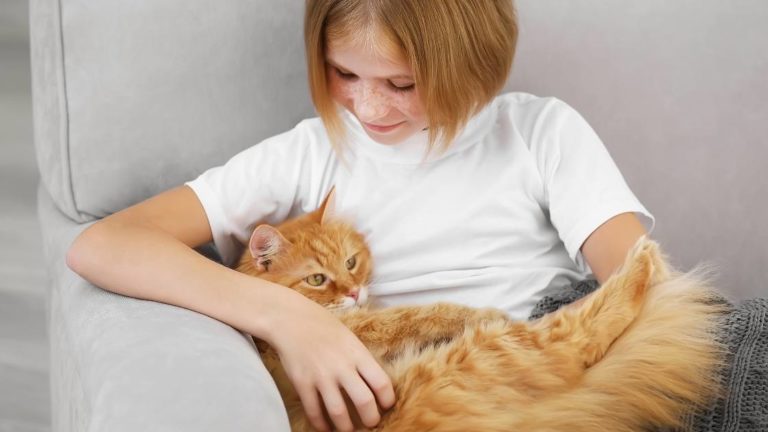Do Cats Hunt Bats? (Why, How & Ways to Protect)
You’re talking about one of the world’s most efficient predators. The cat family includes some of the quickest, sharpest hunters on the planet. They’re stalking, leaping assassins that can take down prey many times their size. But do cats hunt bats?
On the face of it, you wouldn’t think so. Bats are nimble flyers with echolocation that can help them avoid predators. They’re also small enough to fit into tiny spaces, making them hard for cats to catch. So you might assume that bats are safe from their feline enemies.
But you would be wrong. Cats are very good at hunting bats. In fact, they’re one of the biggest threats to bat populations around the world.
In this blog post I’ll try to answer the question: why do cats hunt bats? I’ll also look at the impact that this hunting has on bat populations. Finally, I’ll suggest some ways to protect bats from being hunted by cats.
What is a Bat and What do they Look Like?

Bats are small, winged mammals of the order Chiroptera. With over 1,200 species, they are the second-largest group of mammals after rodents. The majority of bat species are insectivores, but some fruit bats and vampire bats feed on blood.
Bats are found on every continent except Antarctica. Most bat species roost in trees, caves, or under the eaves of houses; however, a few species inhabit arid areas and live in burrows dug into the ground.
Bats range in size from the tiny bumblebee bat, which weighs less than a gram, to the enormous Malayan flying fox, which has a wingspan of up to 2.5 meters. Most bats have dark fur, but a few species are brightly colored.
All bats have wings formed by membranes of skin stretched between their long fingers. When at rest, bats usually hang upside down by their hind legs.
To take flight, they drop from their roosting place and spread their wings to catch updrafts of air. Once airborne, they use their powerful sense of hearing to locate insects on which to feed. Bats fly with great agility, changing direction quickly to avoid obstacles and capture prey. Many species can also hover in mid-air.
Do Cats Go After Bats?

It’s a question that has long baffled scientists: do cats go after bats? While there is no clear answer, there are a few plausible theories.
One possibility is that cats are drawn to the high-pitched calls of bats, which can be similar to the sounds made by small prey animals.
Another theory is that cats view bats as potential competitors for food, since both animals are predators that hunt at night.
However, the most likely explanation is simply that cats are curious creatures, and they enjoy the challenge of trying to catch such agile prey.
Whatever the reason, there is no doubt that cats and bats can make for an entertaining sight – even if the bats usually end up getting away.
Why Do Cats Hunt Bats?
There are a few reasons why cats hunt bats. For one thing, it’s a great source of exercise. Flying is an energy-intensive activity, and chasing after bats can help cats stay in shape.
In addition, hunting bats provides cats with a much-needed dose of excitement. The thrill of the chase gives them a natural high that helps relieve boredom and boredom-related problems like stress and anxiety.
Finally, catching and eating bats can be a nutritious meal for cats. Bats are a good source of protein, fat, and vitamins, and they can help Cats to meet their nutritional needs.
How Do Cats Catch Bats?

Catching bats is not as easy as it looks. These small mammals are incredibly agile, and they can fly at speeds of up to 60 kilometers per hour.
To make matters worse, bats often hunt in groups, making it even more difficult for a single cat to take one down.
Fortunately, cats are natural predators with sharp claws and powerful jaws.
When Hunting in Solo
In solo journey, the best way for cats to catch bats is to lie in wait near their roosting place. When a bat flies by, the cat will pounce and try to grab it with its claws.
If successful, the cat will then use its teeth to kill the bat before it has a chance to escape.
When Hunting in a Group
When cats hunt in groups, they will often surround a roosting area and wait for bats to fly out.
Once the bats are in the air, the cats will take turns chasing after them and trying to catch them.
This method is not always successful, but it’s often the only way for cats to catch bats when they are hunting in large groups.
Can a Cat Kill a Bat?
Yes, a cat can kill a bat. However, it’s important to note that bats are protected by law in many countries, so cats should only be allowed to hunt them if it is legal in your area.
In addition, it’s important to make sure that your cat is up-to-date on its vaccinations before allowing it to hunt bats.
This is because bats can carry diseases that can be deadly to cats, such as rabies.
How Do Cats Kill Bats? (All the Techniques)

I closely observe all the technique that my cats use to kill bats. There are different ways that they use depending on the situation. Here is a in depth guide on how they do it.
Bite the Bat on the Neck
The most common way that I see my cats kill bats is by biting them on the neck. This is a quick and efficient way to kill a bat, and it usually results in very little blood being spilt.
First, the cat will position itself behind the bat and wait for it to land. Once the bat has landed, the cat will pounce and bite it on the neck.
The bat will usually die instantly from the pressure of the cat’s jaws.
Bite the Bat on the Head
Another way that cats can kill bats is by biting them on the head. This method is not as common as biting the bat on the neck, but it is still used occasionally.
To do this, the cat will wait for the bat to land and then pounce on it. The cat will then bite down on the bat’s head, crushing its skull and killing it instantly.
This method is a little more dangerous for the cat, as there is a risk of getting bitten by the bat’s sharp teeth.
Use its Claws to Rip the Bat Apart
Another way that I have seen cats kill bats is by using their claws to rip the bat apart. This method is usually only used when the cat is hunting in a group.
To do this, the cat will wait for the bat to land and then pounce on it. The cat will then use its claws to shred the bat’s body, causing it to bleed to death.
This method is very dangerous for the cat, as there is a risk of getting bitten by the bat’s sharp teeth or of contracting a disease from the bat’s blood.
What Do Cats Do with Bats After They Kill Them?
After killing a bat, cats will usually eat it. This provides them with a source of protein and helps them to meet their nutritional needs.
In some cases, cats will play with the bat before eating it. This is often seen in young kittens, who are still learning how to hunt.
In other cases, cats will kill bats for fun and then leave them behind. This is more common in adult cats who have already eaten and do not need the extra food.
Do All Cats Hunt Bats?
No, not all cats hunt bats. In fact, most cats will never hunt a bat in their lifetime.
Cats that live in areas where there are no bats (such as desert regions) will never have the opportunity to hunt them.
In addition, some cats simply do not have the instinct to hunt. These cats may never hunt, even if they live in an area where there are plenty of prey animals.
Finally, some cats are simply too lazy to hunt. These cats would rather sleep all day than go out and catch their own food.
The Impact of Cat-bat Hunting on Bat Populations

A study in 2008 found that domestic cats in the US catch around 1.3 billion bats every year. That’s a lot of bats! And those are just the ones that we know about. It’s likely that many more are killed by cats but never reported.
According to the study, the most common bats caught by cats are the little brown bat and the big brown bat.
Cats also seem to prefer to hunt male bats over female bats. This is likely because male bats are more active during the day, when cats are more likely to be hunting. So what does this mean for bat populations?
Well, it’s hard to say for sure. The study found that the number of bats killed by cats each year is similar to the number of bats killed by humans (1.4 billion).
This means that cats are not having a significant impact on bat populations. However, it is possible that they are having an impact on certain local populations.
For example, if a large number of bats are being killed in one area but not in other areas, this could lead to a decline in the local population.
Are Bats Dangerous to Cats?
While bats are generally harmless creatures, they can pose a threat to cats if they are carrying certain diseases. One of the most common diseases that bats can transmit to cats is rabies.
While the risk of infection is low, it is still important for cat owners to be aware of the danger. Bats can also carry other diseases, such as lyssavirus and Hendra virus.
These diseases are not as well-known as rabies, but they can still be deadly to cats. In addition, bats may also prey on small mammals, such as rodents and birds.
While this is not a direct threat to cats, it could lead to an increase in the number of parasites in the environment, which could then infect cats. For these reasons, it is important for cat owners to be aware of the dangers that bats can pose to their pets.
Ways to Protect Bats from being Hunted by Cats
It’s really not practical to try to keep cats from hunting bats. After all, it’s a natural instinct for them. However, there are some things that you can do to help protect bat populations from being impacted by cat hunting.
Encourage your Cat to Hunt Other Prey Animals

One way to help protect bat populations is to encourage your cat to hunt other prey animals. This can be done by feeding them a diet that is high in protein and providing them with toys that mimic the hunting process.
You can also take them to an area where there are plenty of other prey animals, such as a nature reserve or park. This will give them the opportunity to hunt without impacting bat populations.
Provide Them with a Safe Place to Hunt

Another way to help protect bat populations is to provide your cat with a safe place to hunt. This can be done by setting up a enclosed space, such as a catio or screened-in porch.
This will allow them to satisfy their hunting instincts without being able to actually catch and kill any bats.
Limit Their Time Outside

Finally, you can also help protect bat populations by limiting the amount of time your cat spends outside. If they are only out for a few hours at a time, they will be less likely to have the opportunity to hunt and kill bats.
You can also keep them indoors at night, when bats are most active.
The Bottom Line
Cats are curious creatures that enjoy the challenge of catching such agile prey. While it’s not always easy to catch a bat, it can be a great source of exercise and excitement for cats.
So if your cat does happen to catch a bat, don’t be too concerned. Just make sure to take the necessary precautions to protect them from any diseases the bat may be carrying.







Cats take a tremendous toll on wildlife, especially birds. They should never be encouraged to hunt wildlife of any kind. Take them to a nature preserve to hunt? What?? Please keep your cats indoors where they will be safe, and to protect wildlife. By the way, I am a cat lover.